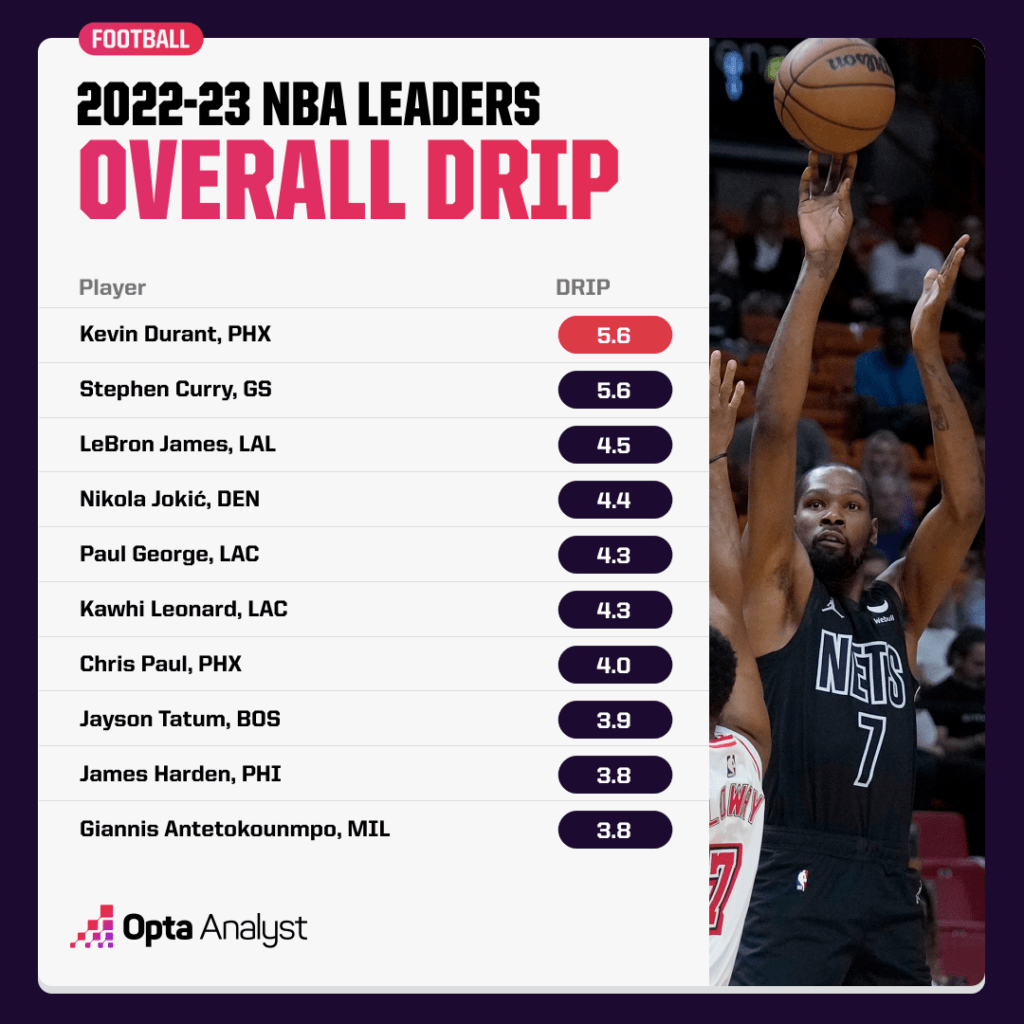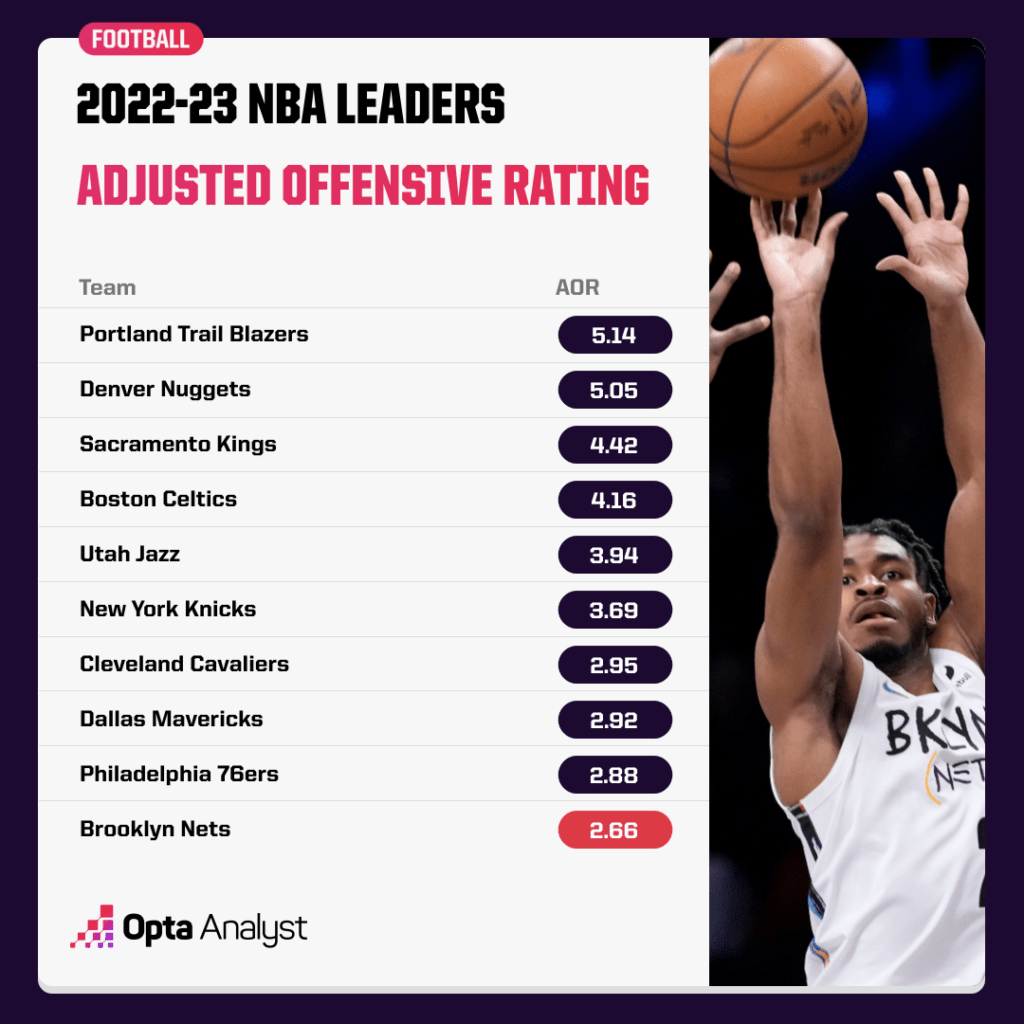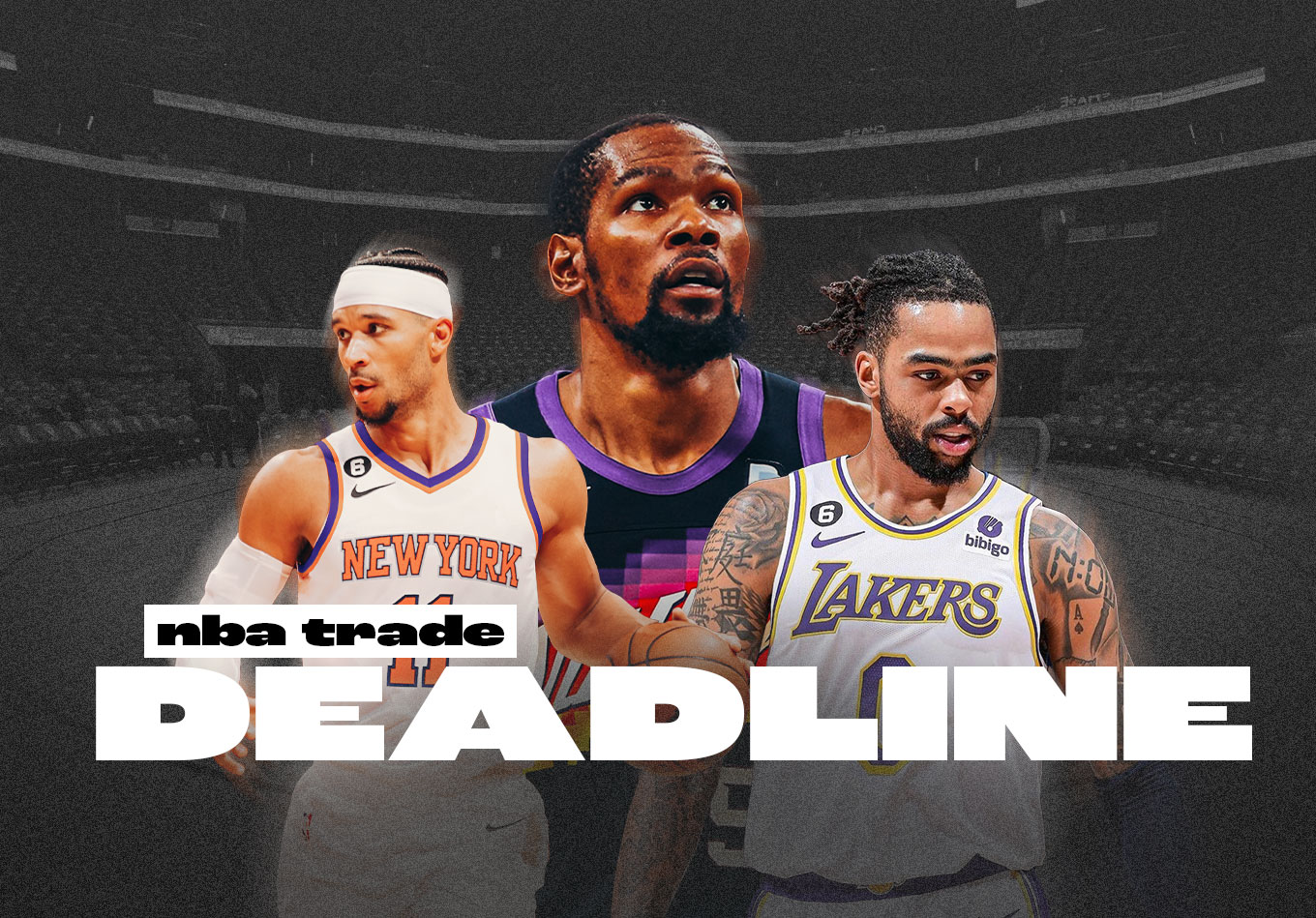Another NBA Trade deadline has come and gone. Nothing eventful really happened this time.
Just your usual megastar getting traded to a different conference in the middle of the night, his now-former co-star getting moved to Texas three days prior, and the Los Angeles Lakers finally moving Russell Westbrook and getting some useful pieces in his place.
Okay, who are we kidding? A LOT has happened. In just a few days, the Eastern Conference lost one title contender, the Western Conference gained two, Gary Payton II is a Golden State Warrior again, the Los Angeles Clippers have some fresh faces, and second-round picks are apparently now tossed around like candy.
Did we mention LeBron James passed Kareem Abdul-Jabbar as the NBA’s all-time leading scorer?
Anyways, with all this chaos, we felt it wise to try and clear out the fog to identify which teams the data identifies as the biggest winners (and losers) of this year’s trade deadline.
Winners
1. Phoenix Suns
What They Gave: Mikal Bridges, Cam Johnson, Jae Crowder, Dario Saric, four unprotected first-round picks (2023, 20225, 2027 and 2029), and a pick swap in 2028
What They Got: Kevin Durant, T.J. Warren and Darius Bazley
Explanation: You remember that one time during a press conference in the 2019 playoffs when Kevin Durant said, “I’m Kevin Durant. You know who I am.”
That’s our explanation for why the Suns won the trade deadline. It’s Kevin freaking Durant. You know who he is. One of the greatest scorers ever. The 7-foot two-way unicorn. The league leader in DRIP (our measure of a player’s contribution to team plus-minus per 100 possessions).

In all seriousness, while there will undoubtedly be questions about depth and this team’s ability to get to generate shots at the rim, Durant vaults this offense to another dimension (addressing the issues we brought up earlier this year), adds rim protection alongside Deandre Ayton, and gives the team a legitimate small-ball 5 element. While probably still not the favorites to win it all, they are a lot closer to winning a title today than they were 48 hours ago.
The Suns, who rank 22nd in our adjusted offensive ratings, needed some offensive punch and they got it with Durant and T.J. Warren.
2. Los Angeles Lakers
What They Gave: Russell Westbrook, Thomas Bryant, Patrick Beverley and Lakers’ 2027 first-round pick (protected 1-4)
What They Got: D’Angelo Russell, Jarred Vanderbilt, Malik Beasley, Davon Reed, Mo Bamba and three second-round picks
Explanation: Let’s not sugarcoat things here. The 2022-23 Los Angeles Lakers roster is fundamentally flawed at 21st in the league in adjusted offensive rating and 20th in adjusted defensive rating (more on these here). If we had to boil the team’s problems down to three main issues, they would be spacing, on-ball creation outside of James, and an overreliance on Anthony Davis on defense.
So what did the Lakers do?
- Add a shooter who can space the floor. Malik Beasley is a career 38% 3-point shooter on 5.7 attempts.
- Add on-ball creation outside of James. Hellooooo, D’Angelo Russell (who, sidebar, is having a career year in efficiency).
- Add more defense to help out the hobbled Davis. Jarred Vanderbilt is a defensive Swiss Army knife, capable of filling gaps that exist on the ball, off the ball, and when protecting the paint.
- Unload Russell Westbrook, who, despite reinventing himself as a sixth man, had been largely underwhelming during his time in Los Angeles. Plus, they only had to give up one of their two first-round picks to do it.
How do these big markets keep catching breaks like this?
3. Los Angeles Clippers
What They Gave: Reggie Jackson, Luke Kennard, first-round pick swap and two second-round picks
What They Got: Bones Hyland, Mason Plumlee, Eric Gordon and three second-round picks
Explanation: This one probably doesn’t make as much sense on the surface as the other two, but bear with us. Like the Lakers, the Clippers had some flaws they were looking to shore up this deadline. And that was most notably their need for a backup center and a point guard who could handle the ball but didn’t always need it in his hands to operate.
And they did just that, netting Mason Plumlee for Reggie Jackson (who had lost his starting gig to Terrance Mann over a month ago) and Bones Hyland for second-round picks (which, as we said, are apparently candy now).
Plumlee gives them some depth behind Ivica Zubac while also giving them some offensive versatility. You see, Zubac’s offensive roll consists primarily of rim running, screening, and offensive rebounding. When he’s out there, the Clippers usually run a 4-out, 1-in offense.
With Plumlee, they now have a big who can operate as a passing up in the post, at the elbow, or on the perimeter (in what is known as a delay set). This means that the Clippers can play a 5-out offense without having to always go to small ball. He also led the Charlotte Hornets with a 0.9 defensive DRIP.
Hyland also perfectly fits the mold of the point guard who can fulfill floor general responsibilities without always needing to dawn that mantle. When he was with the Denver Nuggets, they would often allow him to masquerade as Jamal Murray in his two-man dance with Nikola Jokić. On the season, Hyland is a 38.2% catch-and-shoot 3-point shooter (per NBA.com) – a strong indicator of his off-ball abilities.
Losing a sniper like Luke Kennard is tough, but spot-up shooters become less valuable in the playoffs as defenses will typically run them off the 3-point line (via fly-by contest) and dare them to score off the dribble. Eric Gordon’s experience fending for himself on the undermanned Houston Rockets has made him much more suited for these situations than Kennard, making him a potential upgrade at the position come playoff time.
The Clippers appear to have gotten the help they needed to bolster an offense that ranks 19th in our adjusted team ratings.
Losers
1. Brooklyn Nets
What They Gave: Kevin Durant, Kyrie Irving, T.J. Warren and Markieff Morris
What They Got: Mikal Bridges, Cam Johnson, Spencer Dinwiddie, Dorian Finney-Smith, five unprotected first-round picks, one pick swap in 2028 and four second-round picks
Explanation: In terms of asset exchange, I’d say the Nets came away fairly well given the circumstances. But the reason we have to put them in the loser category is because of how fast everything blew up on them.
A little over a week ago, the Nets looked primed to contend for a title once Kevin Durant returned from his sprained MCL. They’ve been a top-10 team offensively, according to our adjusted team ratings.

Then Kyrie Irving demanded a trade. We thought it wasn’t going to happen. It actually did happen, but somehow Brooklyn managed to recoup a package that still enabled them to compete for a championship this year.
Situation diffused. Now they’ll just regroup and push forward, right? Wrong. Just a few days later, Durant was traded to the Suns. And in the blink of an eye, the championship window in Brooklyn not only closed, but was violently slammed shut right in their faces.
You play the game to win, not hoard assets. And because of that, Brooklyn comes out a loser this week.
2. New York Knicks
What They Gave: Cam Reddish, Svi Mykhailiuk, Ryan Arcidiacono, and a 2023 first-round pick (lottery protected; if it doesn’t convey, it turns into four second-rounders)
What They Got: Josh Hart
Explanation: Asset-wise, the Knicks didn’t have to give up too much to get this deal done. Cam Reddish is one of those young guys that everyone kind of gets excited about simply because he’s young, and Svi Mykhailiuk and Ryan Arcidiacono weren’t seeing much playing time. But that mid-to-late first-round pick in what projects to be a loaded draft class does sting a bit.
The reason they are one of the “losers” of this deadline is that they likely didn’t get the player they think they did. New York has its three focal points in Jalen Brunson, Julius Randle and RJ Barrett. And the team’s goal from there should be to surround that trio with as much defense and shooting as possible, a la a bevy of “3-and-D” players.
Ever since his rookie season, Josh Hart has never had a year when he’s shot over 35% from 3. This year, he’s converting on a mere 30.4% of those attempts. And that’s with teams usually opting to leave him open to help on Damian Lillard and Anfernee Simons.
On defense, it seems like he’s a better defender in theory than in practice. Hart falls just into the negative in defensive DRIP, ranking seventh on the Portland Trail Blazers. That’s not good when considering the Blazers are just 27th in adjusted defensive rating, despite rostering a brigade of “versatile” wings/forwards. Wouldn’t having all these guys make their defense way better? This disparity tells us that the idea of Portland’s wings is likely better than what we’ve seen on the court this year (and that includes Hart).
Hart will also be taking minutes from Quentin Grimes, a player who (ironically) fulfills the “3-and-D” role (and then some) significantly better than him.
3. Denver Nuggets
What They Gave: Bones Hyland, Davon Reed and three second-round picks
What They Got: Thomas Bryant and two second-round picks
Explanation: Do you know why teams collect capital? Ideally, it’s to increase their odds of obtaining promising young talent. However, all too often, it seems, teams trade away promising young talent to stockpile more of this capital (see the San Antonio Spurs trading away Dejounte Murray). That’s what the Nuggets did by trading away Bones Hyland.
It doesn’t matter that he probably wasn’t going to factor much into their postseason rotation this year. It doesn’t matter that his stature presented some pretty massive hurdles for him to overcome defensively (he ranked last on the Nuggets with a minus-1.9 defensive DRIP). It doesn’t matter that he was an inefficient scorer.
He is a young player who has shown upside as a bench guard. He can score both on and off the ball (as we said, they would occasionally have him run the same sets Jamal Murray does) and only Nikola Jokić (3.9), Aaron Gordon (1.3), Murray (2.9) and Michael Porter Jr. (1.7) topped his 0.8 offensive DRIP on the Nuggets. If you’re going to trade him, you have to get something tangible in return – not two second-round picks.
On top of that, while he’s had a really nice scoring season, Thomas Bryant doesn’t really fit what this team needs from a backup big man. A backup behind Jokić should be able to either a) moonlight as the team’s passing hub in his absence or b) offer expertise in the coverages The Joker can’t execute effectively.
Bryant isn’t much of a passer right now, even for his position. He averages 1.5 assists per 100 possessions on the year, which is in the 13th percentile for centers who’ve played at least 25 games.
And as for defense, let’s just say there’s a reason why the Lakers needed to lean so heavily on Davis this year.
